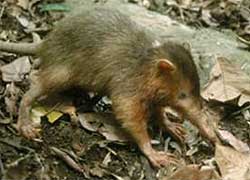Solenodon


Or maybe just "Soooo ugly"!
Solenodon 2


Solenodon are related to the insectivores and can be found in Hispaniola and Cuba. The Solenodons are small, nocturnal omnivores. They eat insects, grubs, small reptiles, fruit and other plant matter. They may produce two litters a year. How are the young fed? The female's two teats are placed on the edge of the buttocks near the tail.
Warning: Gratuitous Spider Sex Link
Now if I were PZ Myers that would be reason enough to talk about them. Maybe even try to find a picture of it and talk about the developmental genetics of it all. But I'm not.
So instead I'm going to talk about venomous mammals. Solendons are one of a few venomous mammals. The others being the duckbilled platypus and several species of shrew (including the North American Short Tailed Shrew) The saliva of a solenodon is venomous and is injected via narrow grooves on it's second lower incisor.
solenodon jaw


Recent genetic research indicates that the solenodon lineage split off from that leading to moles, shrews and hedgehogs approximately 76 million years ago - somehow surving the event that caused the extinction of the dinosaurs.
Curiously enough, a fossil has recently been found dating to about 60 million years ago.
Bisonalveus browni


The fossils consisted of several mandibular fragments and a cranial fragment. Previous finds of this particular creature contained molars only but the new find also had canines - which contained grooves similar to the solenodon incisor (an interesting difference). The fossils have been named Bisonalveus browni and belong to a small shrew like mammal. Researchers have several hypothesis to explain the teeth:
"The likelihood that the saliva was toxic and was required to subdue active prey is high," he said. "But one must also consider that if the animal was a highly active forager … introduction of saliva for digestive reasons could also be important."
Did other mammals of the time have venom:
"The discovery that B. browni and, in all likelihood, a few other extinct mammals used venom to secure prey suggests that venomous mammals were more widespread in the past.
As the fossil record of mammals from B. browni's era improves ... even more venomous mammals will be discovered."
Why don't modern mammals have venom:
"... venom may be scarce among mammals today because predatory mammals use surprise, speed, and strength so efficiently in their attacks, and can inflict lethal damage with teeth and claws".
"The kill can be immediate ... whereas a venom, however sophisticated, takes time."
Added later: PZ Myers has a great post on Bisonalveus browni, including better pictures of the teeth.
It will be interesting to see how these issues are answered.








